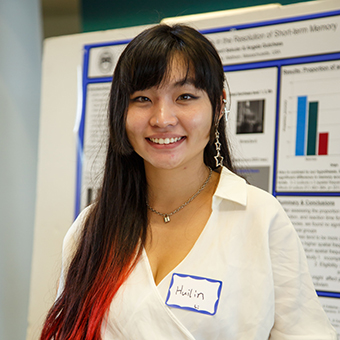Huilin Li
Gutchess Lab
Department of Psychology
Brandeis University
Cross-culture Differences in the Resolution of Short-term Memory
 Prior research has shown that culture can influence the encoding and retrieval process of human memory in cognition. However, questions have been raised concerning the basis for these cross-culture differences, considering the role of perceptual processes of memory.
Prior research has shown that culture can influence the encoding and retrieval process of human memory in cognition. However, questions have been raised concerning the basis for these cross-culture differences, considering the role of perceptual processes of memory.
This study explores whether cross-cultural differences in perception impact short-term memory. We investigated this by manipulating spatial frequency levels. Spatial frequency is a common measurement of perception. It measures how frequently the structure's sinusoidal components repeat per unit of distance; high spatial frequency images contain more fine-grained details at a smaller scale compared with low spatial frequency images of more general information at a larger scale.
In this study, we manipulated spatial frequency by changing the levels of blurriness of 40 scenery images– high spatial frequency images are the clearest, and low spatial frequency images are blurrier than the medium spatial frequency images. We tested the accuracy, as well as responses biases, of short-term memory as a function of the blurriness, or the amount of spatial frequency information, of the image. Participants viewed low, medium, and high spatial frequency images for 2 seconds each. After a 2-second masked delay, they then selected which of three versions of the image they saw earlier.
Based on past work with perceptual tasks, we predict that East Asians will be more attuned to low spatial frequency information whereas Westerners will be more attuned to high spatial frequency information. This will be assessed by comparing the proportion of accurate responses, rate of selection, and reaction time for the trials of different spatial frequencies. Preliminary analyses indicate that both of the cultural groups tend to favor high spatial frequency images with no significant difference between cultural groups.
Personal Statement
This summer, I kept working on my thesis project. Firstly, I built a main PsychoPy task for the study and recruited 20 American participants and 30 East Asian participants. In this PsychoPy task, participants were shown 40 random trials of images and asked to select an identical scene that was shown to them earlier from three identical images with different blurry levels. We have had multiple rounds of piloting the task within the lab, initially finding the task to be too difficult for participants to notice the different levels of spatial frequency contained in the images. Due to this concern, I changed the stimuli to be easier.
We again piloted the study, with the full set of trials, and found that the difficulty level was in an appropriate range. Also, in the summer, I worked on collecting data, scoring responses, and conducting data analysis through the SPSS statistical package. All of this helped me finish and revise my proposal and first draft of my senior thesis.
Giving Back Reflection
With the fellowship money I received, I have been able to help the Brandeis ACC lab recruit more participants for not only my project, but also for my lab mates. When I was cleaning and analyzing my own data for the project, I also helped some first-year and new lab co-workers with the study design and basic PsychoPy programming. I also served as a speaker and lecturer about cognitive psychology research methods in the summer for several psychology presentation workshops.
